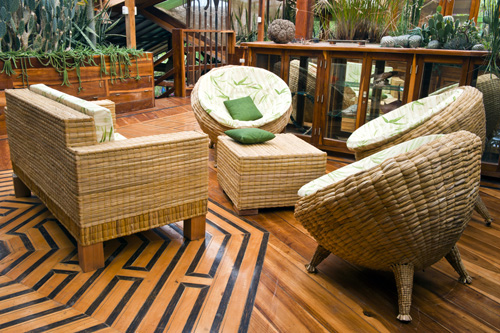
Eco-friendly furniture is the new big thing – and with pressure on resources and the environment it’s not just a trend and its not going to go away any time soon. Sustainable furniture is something that all of us with environmental concerns should think about if we are refurbishing our homes or just buying a new piece or two.
Sustainable furniture comes from renewable resources. That could mean buying pieces made of woods from ethically managed plantations, rather than illegal logging. By researching the company you’re dealing with you should be able to get an idea of how green they are. Even better, before you start shopping check out manufacturers and retailers with an established reputation for green business principles. The FSC (Forest Stewardship Council) is an international, non-profit organization that provides guidance on and certification of sustainable timbers.
Wood alternatives are another way to go if you want sustainable furniture. Wicker and rattan furniture is made from fast growing vines that are eminently sustainable, if sourced from the right supplier. Bamboo is another sustainable resource. There are some negatives to be aware of though. These materials are sometimes heavily treated with pesticides in their growth phase, or chemically treated thereafter. There’s also the carbon footprint of furniture or materials flown in from the other side of the world to consider.
Plastic may not sound like an obvious eco-friendly alternative to wood, but recycled plastic is an ideal material in many ways. Recycled furniture is a favorite for many cutting edge designers and is something to consider for a stylish, funky modern home. If its not the décor look you want for your interiors it might still be the perfect choice for garden furniture, and has the added bonus of being weather resistant and durable.
Another hot designer favorite is reclaimed wood. The artist’s eye can transform what looks like dirty old lumber that’s only fit for the fire into trendy and attractive furniture and fittings. The carbon footprint of furniture made from reclaimed wood can be around 80% less than that of wood made from new timber.
Vintage and retro furniture is another fashionable option if you want a green home. Hunting for gems from yesteryear at auctions and second hand shops is fun, and you could find the perfect pieces for your home. The carbon footprint is little more than whatever gas you need to transport it home. Unfashionable brown furniture can be transformed with a coat of eco-friendly paint, or consider a makeover with decoupage. Vintage pieces are also often ripe for other adaptations that will update them for contemporary taste. It’s a matter of a bit of imagination and a bit of DIY or craft expertise.
Going green with sustainable furniture is easy today, with plenty of options that will give you the look you want, and the satisfaction of knowing you’re helping the planet with your ethical choices.

